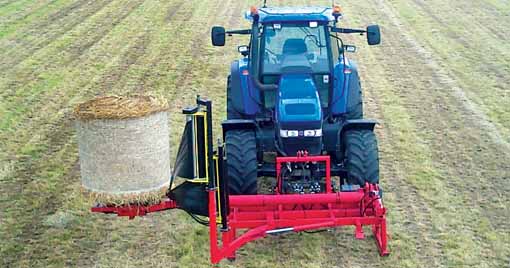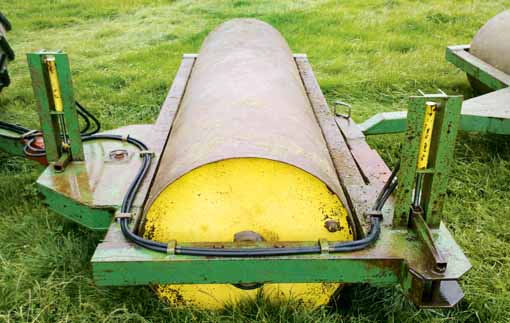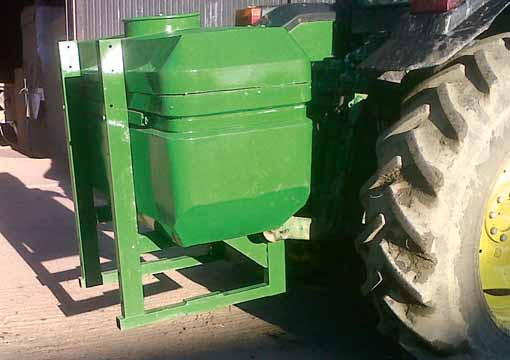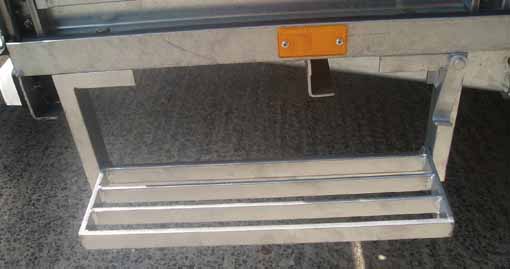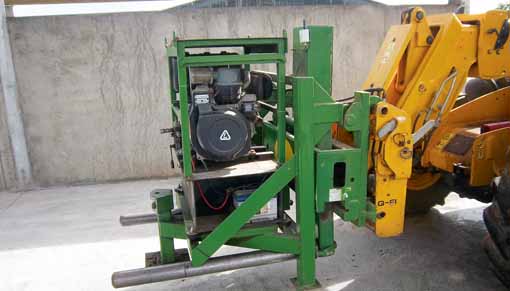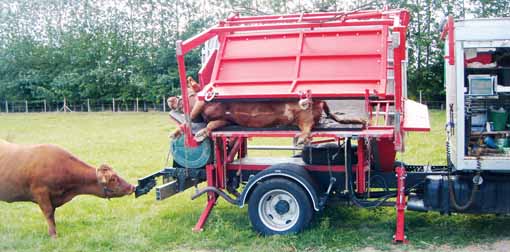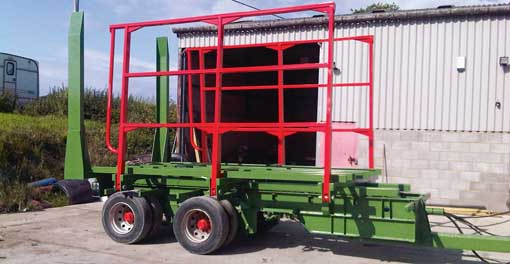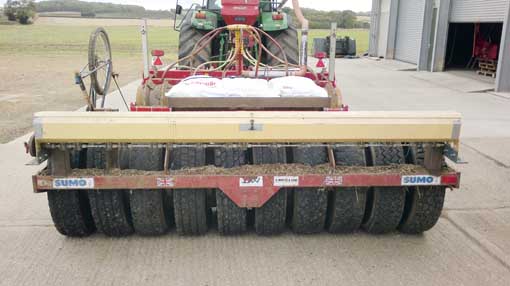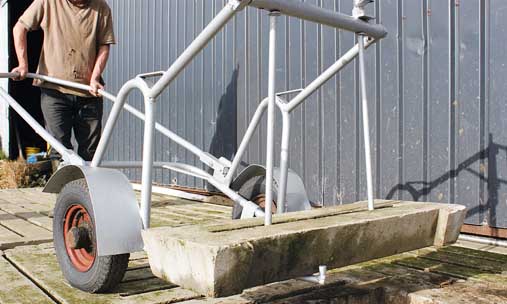Farm inventions competition: highly commended
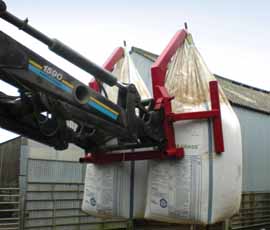
The farm inventions competition attracted 60 entries this year and the winners and runners-up were published in last week’s Farmers Weekly. We round up some of the other competition entries.
David Carbis’ Bag Lifter
Using a fork or grab to pick up fertiliser bags from the lorry was OK in the past, says Cornish farmer David Carbis.
However, much of the fertiliser is now delivered on curtain-sided lorries, most of which have little or no headroom for the farm’s fork or grab to pick the bag up off the lorry bed.
Sometimes the only option is to hook the bag loop on to the tine and then drag the bag off, which is unsatisfactory and potentially dangerous. Forward reach is often a problem too, as many artic trailers can be 1.2m above ground level and reaching the third row of bags on the other side of the truck can be difficult.
Mr Carbis’ new bag lifter reduces the operating height of the loader, which immediately improves forward reach. This, along with the forward-projecting hooks, means reaching that elusive third row of bags is no longer a trial. As the lifter hooks are at the top of the attachment, the headroom needed is reduced to 200mm. Maximum lift height is increased to the extent that bags can now be stacked four high.
The increase in lift height also allows the emptying sock to hang free to empty properly into drills and spreaders. Moreover the lifter has extra hooks, which means it can lift tote bags with four corner loops when the lifter is tipped at a slight angle. This is also good for holding an empty bag under an auger outlet for filling.
One final thing. The hooks point straight up when the attachment itself is upright. This means that with the loader raised you can tip the attachment all the way but the bag will not come off.
JOHN JOHNSTON’S BALE WRAPPER
Fife arable and beef farmer, John Johnston, designed this Wrapide CW-01 wrapper that applies plastic film around the circumference of the bale. It gives a weatherproof cover and means the bales can stay outside during the winter.
It’s a quick process, he says, with work rates of more than 120 bales an hour possible. First, you tilt the turntable forward so the tines are facing the bale, then you drive forward until the tines have penetrated fully into the bale and then stop. Next, you tilt the turntable up 90° so that the bale is lifted up on its end on to the turntable. You then rotate the turntable and wrap the bale, then stop it when aligned. Then you open the cut and hold mechanism and tilt the turntable a further 90° so that the bale is now behind the turntable. You then close the cut-and-hold mechanism and drive forward, leaving the bale behind.
The final step is to tilt the turntable forward 180° so that the tines are facing towards the next bale.
MARK PHILP’S ROLLER LOCKING SYSTEM
Dairy farmer Mark Philp from Looe in Cornwall had already made a set of 4.9m (16ft) folding ballast rollers in his third year at Bicton College in 2006, but soon realised that time was being wasted by having to leave the tractor to remove the pins and fold up the rollers when moving from field to field.
So he came up with a simple hydraulic locking pin system that allowed him to fold up the rollers quickly without the need to leave the cab. Two rams raise and lower both sets of pins at the same time, locking the drawbar in either a transport or work position.
Folding out the rollers is done by using the spool valve to operate the set of pins on the first drawbar, driving the tractor forward to offset the lead roller, then repeating the same to offset the rear roller into work position.
ANDY KELCHER’S WEIGHT BLOCK AND STORAGE BOX
Here’s a clever idea from Andy Kelcher, Morpeth, Northumberland. This 950kg weight block and watertight storage box for the front or back of a John Deere tractor was made from an old Allman 825 Special sprayer. It was cut down, hinges added and then part-filled with concrete. The job took less than half a day to do and it works really well.
GARETH DAVIES’ TRANSPORT TRAILER STEP
This lightweight, one-piece, retractable steel step designed by Llandovery, Carmathenshire, farmer Gareth Davies has given him a much safer way of getting in and out of his stock trailer via the side door.
A step of 75cm has been reduced to 45cm, making entry safer and quicker. The bottom door does not need to be opened to check on stock on the top deck. It’s also retractable and stays within the width of the trailer when not in use.
ALAN RAMSAY’S WRAPPER POWERPACK STAND
Contractor Alan Ramsay uses a McHale HS2000 wrapper both in the field behind a tractor and static at the stack (using a Lupton powerpack), depending on what the customer wants.
He made this useful-looking powerpack stand that can be transported on the bale handler and is attached to the wrapper at the stack. The handler can move the wrapper around the stack as required without the operator leaving the seat and output with two machines (one loading the wrapper and one stacking) can easily hit 80+ bales an hour.
JON CLARKE’S MOBILE ROLLOVER CRUSH
Jon Clarke, a professional foot trimmer from Berwick in East Sussex, built this mobile rollover crush (with the help of a local welder) last winter to replace a trailed model built in 2003.
It’s mounted on an Isuzu chassis cab and works off four 95A batteries that run a 24v hydraulic motor/pump unit that was destined for a Chieftain tank. The batteries also run an inverter, which he uses for a hand grinder, lights and a hotbox for the glue. Having its own power source means that he can set up in remote locations without having to use a generator or run potentially dangerous extension leads up to the machine. A set-up time of less than a minute means that previously uneconomic small jobs are now worth doing.
There’s no front door to the crush, just a yoke. So cattle don’t mind walking into the crush as they can see nothing to stop them going out.
The side pivots in to support the animal, so the same machine can cope with the smallest Dexters to the largest Holstein bulls. Also, with no chains or straps supporting the body, there is no chance of injury to the animal.
PETER WILLIAMS’ BIG BALE STACKER TRAILER
Peter Williams has spent 18 months designing and making this bale trailer, which is designed to transport 14 Quadrant bales from field to shed.
He bought a lorry trailer with air brakes and air suspension, and designed and made a frame from box section steel to fit the lorry trailer. He fitted six hydraulic rams, two to open and close the side gates, another two to squeeze the lower bales of the stack, and two bigger rams to pull the stack on to the trailer.
He added LED lights, renewed the brakes and air bags and added reflectors, all in order to meet safety standards.
He used the stacker trailer for the first time this harvest. It enables him to move bales a lot faster from field to shed, he says, and is proving to be a great asset on the farm.
TONY HULL’S TROUGH SEEDER
Tony Hull put a trough seeder on the back of the tyre packer that he pulls behind the rape drill. The box was bought for £300 but had no drive, so he devised a system that used the gears on a child’s bike. The trouble was it went backwards, so he made a reverse drive gearbox from two old chemical pumps found on the farm.
This has allowed him to apply pellets while drilling while avoiding the risk of them entering the watercourse.
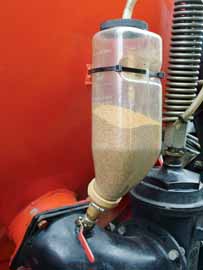 ALBERT O’NEILL’S CLOVER SEEDER HOPPER
ALBERT O’NEILL’S CLOVER SEEDER HOPPER
One increasingly popular way of establishing clover within an existing grass sward is by mixing it in with the slurry, but getting the seed mixed evenly can be a challenge.
Northern Ireland farmer Albert O’Neill improved things by designing this small 3kg hopper. It is fixed to the side of the slurry tanker with its outlet connected to the tanker’s self-fill arm intake pipe.
As the vacuum tanker starts to fill with slurry, the driver opens the small lever valve slightly. This allows the seed to be sucked in gently with the slurry as the load is being filled, giving a more consistent mix of slurry and seed.
The hopper is made of clear plastic, so the operator can see the seed flowing and can adjust the flow rate according to the time it takes to fill the tanker with slurry. A breather pipe is fitted to the lid.
This method of slurry seeding makes it much easier to accurately gauge the amount of seed a hectare and should give a much more even distribution across the field, says Mr O’Neill. Results have been good over the last three years, he reports.
ROBERT BECK’S SLAT LIFTER
Robert Beck made this unit to provide a safe and efficient way to remove and replace the concrete slats on slurry tanks.
The disused mobile milk tank transporter provided a manoeuvrable and balanced frame on which to mount a set of linked and contra-rotating slat-lifting rods. Individual slats can also be lifted by disconnecting the linkage mechanism. It has been in use for five years, making what has been traditionally a strenuous job into something virtually effortless.

